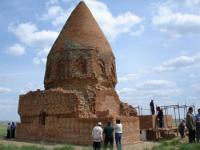You are here
History mausoleum Abat Baitak.

Tourism and travel in Kazakhstan.
“First of all, it should be remembered that without accurate data on the nature of the material from which the object is built, not knowing its properties and processing techniques, it is generally impossible to undertake restoration..."
M.V. Farmakovsky.
Monuments of history and culture of Aktybinsk region.
The first mention of scientists about the Abat Baitak mausoleum dates back to the XVIII century and belongs to the second lieutenant and engineer Rigelman. The following, more complete, description of the archeology monuments of the region was associated with the research of Russian scientists in the Orenburg region and the adjacent regions of Western Kazakhstan in the middle of the XVIII century.
Pyotr Rychkov then gave a detailed description of the natural and geographical conditions of the region, etc. The Orenburg Scientific Archival Commission created in the second half of the 19th century brought together representatives of the advanced thought of that time and did a lot to study the monuments of the region.
The results of the work of enthusiasts and local historians were published in a special publication, Proceedings of the Orenburg Scientific Archival Commission. The monument was recorded by P.I. Rychkov at the end of the eighteenth century under the name - Baytan.
A member of the Orenburg Scientific Archival Commission, J. Ya. Polferov, took part in the description of the monument. In 1910, the French explorer Joseph Castagne conducted independent excavations in the territory of Western Kazakhstan and published a summarizing work, “Antiquities of the Kyrgyz Steppe and the Orenburg Territory,” which included descriptions of many ancient cultural monuments.
He was one of the first to collect materials on the famous Abat Baitak mausoleum, even made some graphic drawings on it. In the Soviet period, studies in the region began in the 1920s, but then they were episodic in nature.
After that, for a long time it was believed that the mausoleum was destroyed and forever lost to the scientific community. However, in 1979 - 1980. the expedition "Kazrestoration" of the Ministry of Culture of Kazakhstan under the leadership of S. Adzhigaliev entered it into the register of protected monuments of republican significance.
It took the specialists about three years to restore the dilapidated mausoleum. Restoration was not an easy job. Indeed, in order to restore the mausoleum, it was necessary to initially study the materials from which it was once built.
And try to make something close in composition. It turned out that the ancient builders used local clay. The restoration of Abat Baitak was entrusted to Turkestan restorers. A total of 32 thousand bricks were required.
In 1982, the necropolis was included in the list of monuments of history and culture of republican significance and was taken under state protection. Only in 2004, the first expedition of scientists led by Erbol Smagulov began a comprehensive study of not only the mausoleum itself, but also its environs.
By that time, the graves had already been looted, and many things of value were most likely stolen. Five graves were found in the mausoleum (middle-aged men, women, a teenager and two children), the remains of wooden coffins, a metal mace (possibly the staff of a missionary suffess), the remains of clothes.
The surroundings of the mausoleum were also examined. After research, the Abat Baitak mausoleum was restored, for which about 30 million tenge was allocated from the republican budget under the Cultural Heritage program and 3.5 million tenge from the regional budget for the construction of a brick kiln.
In order to fully lay out the mausoleum, the craftsmen needed to make 32 thousand bricks.
Authority:
"Religious and spiritual monuments of Central Asia." Author M. Khashimov. Saga Publishing House, Kazakhstan, National Encyclopedia 4 vol.2001. http://www.madenimura.kz
.







